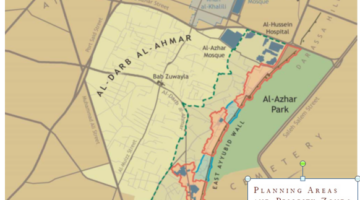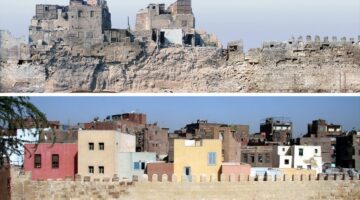



Al-Darb al-Ahmar Housing Rehabilitation Programme (ADAA HRP), Cairo
Main objectives of the project
The district of Al-Darb al-Ahmar in Cairo holds significant historical importance, yet its approximately 100,000 residents are among the most economically disadvantaged in the city. Despite being home to numerous Islamic landmarks, the area suffers from inadequate infrastructure and services, leading to a high prevalence of health issues among its inhabitants. In response, the Housing Rehabilitation Programme (HRP) was initiated to enhance both the quality and quantity of housing while adhering to health standards and preserving the district's architectural heritage. Launched in 2004 with a goal of rehabilitating 200 houses by the end of 2009, the programme has since continued with ongoing efforts, reliant on the involvement of local communities and contributions from various donors. The HRP is committed to improving housing conditions sustainably by addressing the root causes of deterioration through a collaborative, multidisciplinary approach involving all stakeholders. The goal is to change the “Action Areas” and the surrounding of monuments into vivid communities.
Date
- 2004: Rehabilitación
Stakeholders
- Promotor: Aga Khan Trust for Culture
- Aga Khan Agency for Microfinance
- Ford Foundation
- Cairo Government
Location
Country/Region: Cairo, Egypt
Description
The Greater Cairo Region, with a population exceeding 18 million, confronts substantial challenges, notably over half residing in informal settlements. The Cairo Governorate alone hosts over 7 million inhabitants, positioning Cairo as one of the Arab world's most populous cities boasting a rich Islamic architectural heritage. Over the past century, urban management policies have grappled with the region's burgeoning population and associated issues such as informal housing proliferation, overcrowding in historic areas, and the deterioration of ancient urban fabrics due to transformations and gentrification.
Less than two centuries ago, al-Darb al-Ahmar epitomized wealth in Cairo. Today, its 100,000 residents, living within a historic district spanning 1.2 square kilometers, rank among the city's poorest. Despite its central location, historical significance, and vibrant community, living conditions have steadily deteriorated, resulting in a 50% population decline since the 1970s. Contributing factors include infrastructure neglect, low incomes, and the degradation of monuments and private housing. Outdated planning regulations, coupled with tenure insecurity and unrealistic rent controls, exacerbate the situation. Nonetheless, al-Darb al-Ahmar maintains social cohesion and architectural authenticity, necessitating interventions meeting varied needs while upholding health standards. Thus, the Housing Rehabilitation Programme emerged, advocating against neighborhood demolition while enhancing housing quality and quantity, preserving original architectural elements.
In 1999, a survey in the Aslam Mosque neighborhood kick-started efforts to identify planning and housing strategies for area-wide preservation and development. Subsequent baseline surveys in 2003 revealed alarming deficiencies, with 22% of dwelling units lacking private lavatories, 51% deprived of consistent water sources in kitchens, and 32% suffering from non-ventilated rooms. Despite declining living conditions, 86% of residents expressed a desire to remain in al-Darb al-Ahmar.
The Aga Khan Trust for Culture spearheaded redevelopment post-survey, focusing on physical upgrades and socioeconomic development. By 2004, completion milestones included 19 community-owned houses, a health center, a business center, school building restoration, and reconstructed minarets. Additional housing rehabilitation projects ensued, supported by microcredit programs. Subsequent phases targeted broader infrastructure enhancements and private investment facilitation. Emphasizing local engagement and capacity-building, the project ensured staff recruitment from the al-Darb al-Ahmar community, foreseeing self-sustaining credit services and envisioning microcredit activities evolving into a formal microfinance bank.
The policy targets the residents, businesses, and social groups within the district. The proposed urban improvement program by AKTC necessitates coordinated physical, social, and economic efforts sustained over an extended period. It also emphasizes the importance of institutional capacity-building, including supporting the establishment of local NGOs across various domains until they can operate with reduced assistance. Additionally, a public/private Development Corporation has been set up as an overarching entity in Al-Darb al-Ahmar, tasked with coordinating ongoing activities, generating income from restored facilities and services, and ultimately overseeing a self-sustained rehabilitation process. Furthermore, there is a focus on promoting community awareness and self-governance as a means of restoring the traditional Muslim city feature in residential areas and enhancing cultural awareness among residents.
Resource types, roles, and team players are diverse. It has financial resources from the Social Fund for Development, Aga Khan Trust for Culture, and Ford Foundation grants; residents’ direct financial and in-kind contributions (cost share 30% to 50% of rehabilitation costs); and Aga Khan Agency for Microfinance’s housing loans to support different income levels. The technical expertise in rehabilitation comes from the Aga Khan Trust for Culture and the Community Development Corporation; partners at different levels ranging from Cairo Governorate, municipal authorities, community-based organizations, to communitymembers; and local HRP staff providing administration and technical support. And, as we stated, there is Microenterprises, suppliers, and small contractors in Al-Darb al-Ahmar providing construction and finishing works.
To bolster physical rehabilitation efforts, the Housing Rehabilitation Programme (HRP) has enlisted a social housing team. This team aids in procuring the necessary legal documentation for building rehabilitation, mediates among stakeholders, and ensures that all non-physical conditions are addressed prior to the commencement of physical rehabilitation. Once a preliminary agreement is reached with residents of earmarked buildings, an independent credit team evaluates the creditworthiness of individual families. Consequently, microcredit loans are allocated based on each family's earnings. This microcredit scheme serves both tenants and property owners while ensuring secure tenure. Notably, through negotiations with tenants, property owners, and public authorities, approximately 285 households facing eviction due to deteriorating structural conditions were granted secured tenure status. These households were part of the housing stock at risk of demolition, and their rehabilitation allowed tenants to retain their residences.
The Housing Rehabilitation Programme catalyzed policy shifts, influencing demolition regulations and urban planning practices to prioritize community needs and conservation. Notable outcomes include a decree protecting existing housing stock near monuments and a revised conservation plan fostering community involvement. In summary, the program safeguarded residents' tenure, established national planning norms acknowledging community needs, and circulated a significant percentage of rehabilitation costs within the community, fostering job creation and supporting local businesses.

